PERSPECTIVE ON CHILDREN : No Time for the Young in America : During the U.N. World Summit for Children, let’s remember we have a current and growing debt to our own.
As a former teacher and principal, I am keenly aware that society sees patience as one of the most valued qualities in those of us who work directly with children. But, given the evidence of how much we have raised the ante on growing up, it is now clear to me that in matters involving children, patience is no longer a virtue. In fact, at a time when children and childhood are in terminal danger, being patient is irresponsible if not outright criminal.
There is a critical need for action in behalf of children, but some formidable obstacles stand in the way.
* The rapid pace of changes in the structure of the American family, traditional institutions and gender roles seems to have outstripped our ability to adapt.
* Changing social conditions, especially the greater availability of drugs and the attendant pervasive violence, along with the widening chasm between the “haves” and “have-nots,” have made this a time when events are in the saddle and ride mankind (to rephrase Ralph Waldo Emerson).
* The habitual thinking of children as “our future” seems to excuse us from paying sufficient attention and resources to them in the present.
* Our confusion between “adult time” and “child time” blunts our sense of urgency. We accept that it may take a year to initiate a child-rescue program, forgetting that the year between 5 and 6 for a child is much longer than the year between 35 and 36 for an adult. This fosters our propensity to label children as “at risk” when it really should be “in trouble.”
This weekend, more than 80 nations are participating in the World Summit for Children at the United Nations. Much of the attention will be--and deservedly so--on the children of the world’s most impoverished countries. Let’s hope that the United States’ response will be generous. But let’s remember that we have an outstanding, and growing, debt to our own.
Their crisis is real: We are a country at peace, yet an increasing number of our children are living in war zones; increasingly, they are forced into premature adulthood; in the words of poet Ina Hughs, “their nightmares come in the daytime.”
The lexicon describing children in the United States today--crack babies, cross-fire children, shelter kids, throwaways--should prompt us to question if we merit the title of “civilized nation.” Add to this litany the parlance of shameful childhood modifiers: We are no longer shocked when children are referred to as homeless, abused, abandoned or missing.
Each time the media makes us aware of yet another horror committed against a child, we shudder, then shrug and tell ourselves that, surely, these are just aberrations.
Less than a year ago a congressional report based on a thorough review of the status of our nation’s children and youth concluded that childhood is actually dangerous for children in this country. The Children’s Defense Fund churns out facts that might legitimately provide the basis for a class-action suit against all adults for endangering the welfare of American children.
As individuals we claim to cherish children while collectively our behavior seems to prove otherwise. We debate the merits of child-care legislation in a child-care-less society. As the ante is raised on growing up, so is our indignation. But this indignation has yet to be translated into an agenda, a platform of concrete actions or legislation that unequivocally demonstrates that we do care about our children.
On the occasion of the World Summit for Children, let’s consider some of the things we can do in our own country to make our commitment unequivocal (note, too, that most of them are cost-free):
* Adopt a child-impact policy. Examine all existing legislation and all proposed legislation in light of how it would affect children.
* Appoint a Cabinet-level child advocate general to develop and direct a coherent and comprehensive children’s policy, create useful and realistic legislation and champion children’s rights and needs. This, in turn, might be effectively carried out at the state and local levels, as well.
* Issue U.S. government children’s savings bonds to provide an opportunity to earmark resources specifically for improved and better-coordinated children’s services.
* Make schools the loci of children’s advocacy so that they, as the only agency seeing every child every day, can accept responsibility for mobilizing available resources and generating new ones as needed. (An advocacy role does not mean that the school itself must provide or perform the necessary services.)
* Direct any new funding for children’s programs to coalitions of professionals. We can no longer afford the luxury of specialists working in isolation of each other. Much more could be accomplished if professionals in health, education, welfare and parenting shared and combined their expertis.
Using the children’s summit as a catalyst, we must summon our most passionate and compassionate individual and national instincts to ensure that every child will develop to the limits of his or her capacity. As a nation dedicated to individual freedom and dignity, we can do no less.
More to Read
Sign up for Essential California
The most important California stories and recommendations in your inbox every morning.
You may occasionally receive promotional content from the Los Angeles Times.










